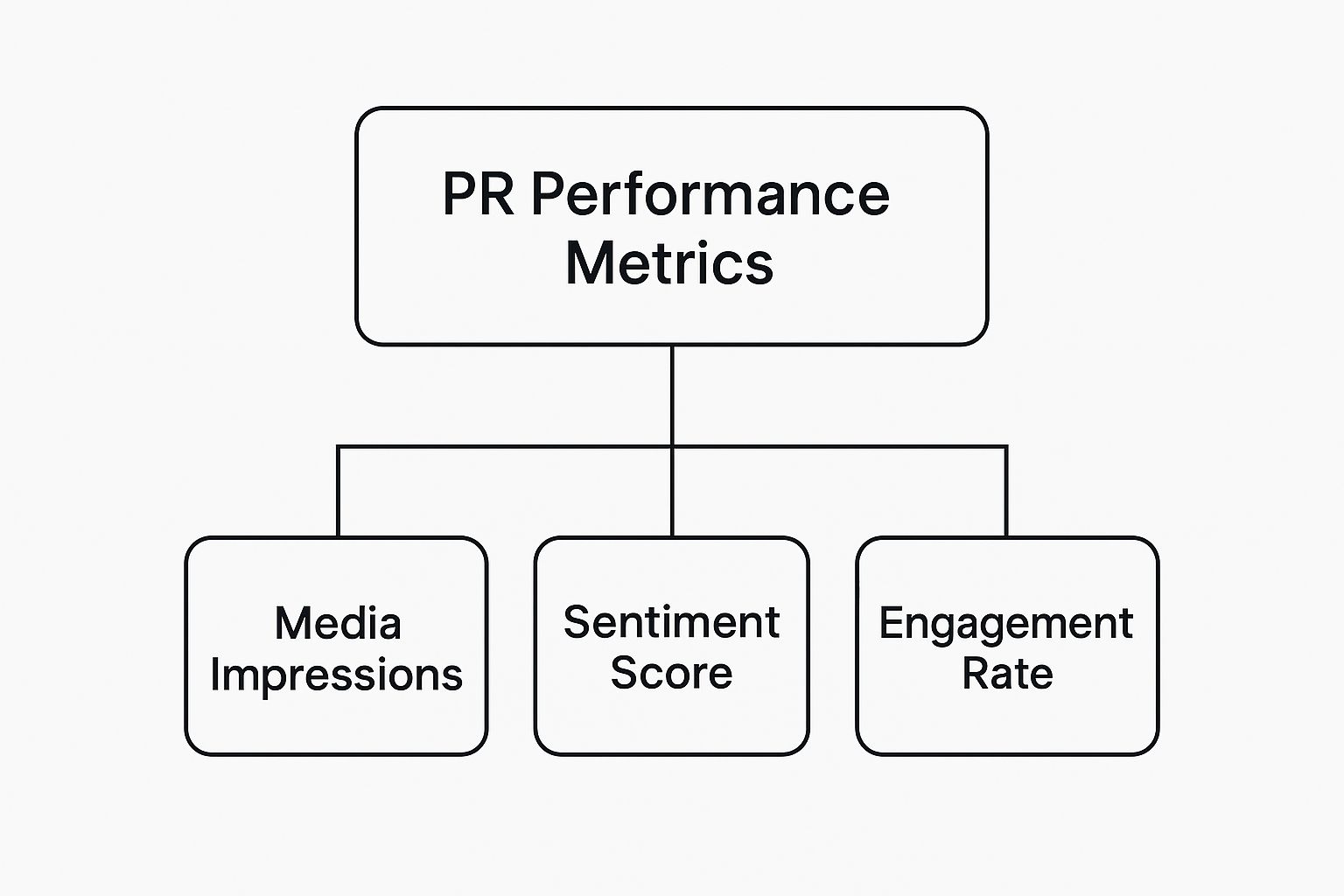
Strategy in PR That Actually Works: Proven UK Tactics
What Really Makes PR Strategy Work

A successful PR strategy in the UK isn't about churning out endless press releases. It's about a focused, targeted approach that seamlessly aligns with your core business objectives. This means truly understanding your audience, crafting narratives that resonate, and proving the value of your efforts with measurable results. Let's explore the core components of a winning PR strategy.
Defining Clear Objectives and Target Audience
The cornerstone of any effective PR strategy is a crystal-clear understanding of your goals. What are you hoping to achieve? Increased brand awareness? A surge in sales? Effective crisis management? Defining SMART objectives—Specific, Measurable, Achievable, Relevant, and Time-Bound—is essential.
For example, a SMART objective might be: "increase website traffic by 20% in the next quarter through targeted media coverage." This focused approach provides clear direction and makes it easy to track progress.
Knowing your audience is equally crucial. This involves understanding their media habits, online behavior, and the influencers who shape their opinions. Where do your ideal customers get their information? Are they reading the Financial Times, scrolling through Twitter, or tuning into industry podcasts? This knowledge informs your channel selection and messaging strategy.
Crafting Compelling Narratives and Building Relationships
A powerful PR strategy hinges on compelling narratives that capture the attention of your target audience. This goes beyond simply promoting your product or service. It’s about telling stories that connect with people on an emotional level, showcasing your brand's values, and fostering genuine connections.
Imagine you're a fintech startup. Instead of focusing solely on the technical features of your app, highlight how it empowers users to take control of their finances and achieve financial freedom. That’s a story that resonates.
Building strong relationships with journalists, bloggers, and influencers is also paramount. This involves understanding their areas of expertise, providing them with valuable content, and nurturing a rapport built on mutual respect. A targeted approach to media relations yields far better results than generic press releases.
Measuring Impact and Adapting Your Approach
Measuring the impact of your PR activities is vital. While traditional metrics like media mentions still have their place, they only paint part of the picture. Modern PR professionals focus on metrics that demonstrate tangible business value, like website traffic, lead generation, and brand sentiment. Tools like media monitoring software and social listening platforms offer valuable insights into campaign performance.
The media landscape is in constant flux. What works today might not work tomorrow. Continuously monitoring your results, analyzing the data, and adapting your strategy is key to long-term success. This might involve refining your messaging, exploring new channels, or adjusting your target audience. A dynamic approach allows you to stay ahead of the curve and achieve your PR goals in the ever-evolving UK market.
Using Data to Build Smarter PR Campaigns

Moving beyond gut feelings and embracing data-driven decision-making is essential for successful PR strategy in the UK. This means using technology to gain deeper audience insights and create campaigns that truly resonate. This shift towards data-driven PR is changing how agencies approach strategy, allowing us to move beyond guesswork and towards evidence-backed planning.
In the UK, the role of PR professionals is evolving with the integration of AI and digital tools. By mid-2025, using AI to quickly analyze large amounts of data became a crucial tool for PR professionals. This enabled them to gather meaningful audience insights at a previously unimaginable scale. Explore this topic further.
Understanding Your Audience Through Data
Data allows PR professionals to paint a detailed picture of their target audience. This goes beyond basic demographics to provide insights into their online behavior, media consumption habits, and the influencers who shape their opinions.
Social listening tools, for example, reveal what your target audience is talking about, their sentiment towards your brand, and their key concerns. This information is invaluable for crafting targeted messages that truly connect.
Website analytics also provide crucial data on user behavior, helping you understand which content resonates, which calls to action are most effective, and how users navigate your site. This data-driven approach informs content creation, ensuring your message reaches the right people at the right time.
Sentiment Analysis: Gauging Public Opinion
Sentiment analysis, also known as opinion mining, uses AI to determine the emotional tone behind online conversations. This powerful tool allows PR professionals to understand how the public perceives their brand, their competitors, and relevant industry trends. This means you can identify potential PR crises early on and respond proactively.
Sentiment analysis isn't just about managing negative sentiment, however. It's also about identifying opportunities. For example, positive sentiment around a particular product feature can inform future marketing campaigns and product development. This data-backed approach helps ensure your PR efforts align with public opinion.
Measuring PR Campaign Performance with Data
Data plays a crucial role in measuring the effectiveness of your PR campaigns. Traditional metrics like media mentions still have value, but modern PR professionals are increasingly focused on demonstrating tangible business impact. This means tracking metrics such as:
- Website traffic
- Lead generation
- Conversion rates
Furthermore, data enables PR teams to optimize campaigns in real-time. By analyzing campaign performance data, you can identify what’s working, what’s not, and make adjustments accordingly. This iterative approach ensures your PR strategy remains effective and delivers measurable results. This might involve refining your messaging, adjusting channel selection, or reallocating resources to maximize impact. Ultimately, data empowers PR professionals to make smarter decisions, build stronger campaigns, and demonstrate the value of their work to stakeholders.
Blending Traditional PR With Digital Marketing

Modern PR strategy requires a harmonious blend of traditional and digital marketing techniques. Many UK agencies are still refining their approach to this integration. This section explores how leading UK agencies are successfully weaving together PR and SEO strategies to amplify media coverage and boost online visibility, ultimately delivering tangible results. We'll examine how these integrated strategies leverage multiple channels for a powerful, focused impact, allowing you to connect with a broader audience without overextending your resources.
Aligning PR Strategy With Digital Marketing Objectives
Effective PR in today's interconnected world necessitates aligning your strategy with overarching digital marketing goals. This involves a shift in perspective, moving beyond securing media mentions to actively driving business growth. PR activities should directly contribute to key performance indicators (KPIs) such as website traffic, lead generation, and conversions.
For instance, a PR campaign centered on thought leadership can generate valuable backlinks to your website, improving your search engine rankings and driving organic traffic. Simultaneously, amplifying PR content on social media can broaden its reach and engage a wider audience. Learn more in our article about How to master digital PR strategies. This holistic approach ensures that PR efforts contribute meaningfully to the overall digital marketing ecosystem.
Content Distribution and Influencer Engagement
Compelling content is the cornerstone of any successful digital marketing strategy, and PR is no exception. Crafting high-quality, engaging content that resonates with your target audience is paramount. However, creating exceptional content is only half the battle. Strategic distribution is crucial for maximizing its impact.
This involves utilizing both traditional and digital channels to connect with your intended audience. Securing coverage in relevant online publications can drive traffic back to your website, amplifying your message and enhancing brand visibility. Influencer engagement also plays a pivotal role in content distribution. Collaborating with relevant influencers can significantly extend the reach of your PR campaigns.
Social Media Amplification for Real Business Outcomes
Social media is an invaluable platform for amplifying PR efforts and driving measurable business results. Sharing positive media coverage, interacting with industry influencers, and participating in relevant online discussions can dramatically increase brand visibility and reach. Social media should be an integral component of your PR strategy, not a secondary consideration.
Moreover, social media offers valuable opportunities to gather audience feedback and monitor brand sentiment. This data can inform future PR campaigns and ensure your messaging truly connects with your target audience. The strategic importance of digital PR in the UK is evident in how brands are weaving it into their marketing mix. In 2025, digital PR continues to gain momentum, with a focus on data-led campaigns and integrated PR and SEO strategies. This approach is essential for maintaining relevance and securing top-tier media coverage in a dynamic media landscape. Discover more insights about this topic. By aligning your PR strategy with your digital marketing objectives, you can create integrated campaigns that deliver real business results. Through the fusion of traditional and digital PR tactics, UK businesses can achieve maximum impact and attain new heights of success in the digital sphere.
Creating PR Strategies That Connect With Everyone
Reaching diverse audiences in the UK requires a PR strategy that truly understands and connects with their unique needs. Effective PR is about building authentic relationships, and that begins with recognizing the vibrant tapestry of communities and perspectives that make up the UK. This means moving beyond generic campaigns and embracing a more nuanced, inclusive approach.
The Importance of Diversity in PR Strategy
Diversity in PR is not just a trend, it's a fundamental requirement for success. A truly diverse strategy allows you to connect with a wider audience, fostering stronger relationships and achieving greater impact. Consider the rich variety of communities across the UK, each with its own cultural nuances and perspectives. A one-size-fits-all approach simply won't resonate.
For instance, a campaign targeting young professionals in London would likely require different channels and messaging than one aimed at families in Manchester. Understanding these differences is key. The current state of diversity within the UK PR industry itself also presents a challenge. Current data reveals that 87% of PR practitioners are from a white ethnic background, and 45% are between 16 and 34. More detailed statistics can be found here. This highlights the need for more diverse voices within the strategic planning process.
Incorporating Diverse Perspectives into Your Planning
Building an inclusive PR strategy starts with thorough research. Understanding the demographics, values, and media consumption habits of your target audience is paramount. This goes beyond basic demographics and involves delving deeper into the specific needs and interests of different communities.
Actively involve practitioners from diverse backgrounds in your planning. Their insights can be invaluable in shaping campaigns that are both authentic and impactful. This collaborative approach ensures that your strategy reflects the lived experiences of the people you’re trying to reach. Explore new ideas and perspectives, such as those discussed in How to master technology public relations.
From Audience Research to Message Development
With a deep understanding of your audience, you can craft messages that truly resonate. Consider the language, tone, and cultural context that will be most effective for each specific group. Always prioritize authenticity.
Avoid tokenism. Your messages must be genuine and reflect a true understanding of the communities you’re engaging with. This requires moving beyond superficial representation and connecting with diverse communities on a more meaningful level.
Channel Selection and Campaign Execution
Choosing the right channels is crucial for reaching your diverse audiences. Different communities engage with different media platforms. Some may prefer traditional media like newspapers and television, while others are more active on social media platforms or online forums.
Base your channel selection on your audience research. A multi-channel approach is often essential to reach a broad range of demographics effectively. This could involve a combination of traditional media outreach, social media engagement, influencer marketing, and community events. By strategically selecting the right channels, you can maximize your message's impact. This targeted approach is far more effective than a generic strategy.
Building Your PR Strategy Framework Step by Step
A strong PR strategy in the UK needs a solid framework. Sadly, many online templates just don't deliver. This section offers proven methods for building a comprehensive PR strategy that truly aligns with your business objectives and audience needs. We'll explore practical, step-by-step approaches for each key phase, providing a clear roadmap for creating adaptable and effective campaigns.
Conducting a Situation Analysis
Before launching into tactics, it's essential to grasp the current landscape. A situation analysis means thoroughly assessing your current position, examining both internal and external factors affecting your brand. This crucial first step sets the stage for strategic decision-making.
This analysis involves evaluating your brand's existing reputation, identifying your main competitors, and analyzing industry trends. Ask yourself: are there any emerging technologies or regulatory changes that could influence your PR efforts? Answering these questions helps define the context for your strategy.
Setting Strategic PR Objectives
After understanding the landscape, you're ready to set strategic objectives. These objectives should be SMART: Specific, Measurable, Achievable, Relevant, and Time-Bound. A vague objective like "increase brand awareness" lacks direction. Instead, aim for something concrete, like "increase website traffic from media coverage by 15% in the next quarter". This provides a measurable target to strive for.
These objectives must directly support your overall business goals. If expanding into a new market segment is a business goal, your PR objectives should reflect this. You might target publications and influencers who connect with that specific audience.
Identifying Key Messages That Resonate
Your key messages are the central narratives you want to share with your target audience. These messages should be concise, compelling, and in harmony with your brand values. Think of them as the elevator pitch for your brand or campaign.
If launching a new sustainable product, for instance, your key messages might focus on its eco-friendly aspects, its positive social impact, and its cost-effectiveness. Carefully crafting these messages ensures consistent communication across all channels.
Selecting Appropriate Tactics and Channels
Once your messages are defined, choose the tactics and channels to reach your target audience. This could involve traditional media outreach, social media engagement, content marketing, or influencer partnerships. Select channels that align with your audience's media habits.
Think about your ideal customer. Where do they get their information? Are they reading The Guardian, engaging with certain influencers on Instagram, or participating in industry forums? This insight guides your efforts.
Building Adaptability Into Your Strategy
The PR world is ever-changing. A static strategy won't work. Your framework needs to adapt to evolving circumstances and new opportunities. This means constantly monitoring and evaluating your results.
If a specific tactic isn't yielding the desired results, be ready to adjust your approach. This might involve refining your messaging, exploring different channels, or reallocating resources.
Comparing PR Strategy Frameworks
Different frameworks suit different campaign types. To help you choose the right one, let's examine a few popular options:
To help you decide which framework best suits your needs, here's a comparison table:
| Framework Type | Best Used For | Key Strengths | Implementation Time |
|---|---|---|---|
| PESO Model | Integrated campaigns across multiple channels | Holistic approach, maximizes reach | Moderate |
| RACE Framework | Goal-oriented campaigns focused on measurable results | Clear structure, emphasizes accountability | Moderate |
| Agile PR | Fast-paced environments, reactive campaigns | Flexibility, quick adaptation | Short |
| Traditional PR | Building media relationships, reputation management | Established methods, industry expertise | Moderate |
This table highlights the strengths and ideal uses of each framework, allowing you to choose the best fit for your campaign. Consider factors like your available resources, campaign goals, and the pace of your industry.
By following these steps, you can develop a robust PR strategy framework that informs your decisions and ensures your campaigns are effective, adaptable, and in sync with your business goals. This structured yet flexible approach is vital for navigating the vibrant world of PR in the UK.
Measuring What Actually Matters in PR

The infographic above offers a visual representation of how to structure your PR performance metrics, highlighting key indicators like Media Impressions, Sentiment Score, and Engagement Rate. These metrics provide a valuable window into how your campaigns perform, revealing how your target audience truly connects with your message. By tracking these vital signs, you move beyond superficial numbers and towards data that reveals genuine impact.
Effective PR measurement forms the crucial link between a well-crafted strategy and truly exceptional results. Yet, many UK agencies are still relying on metrics that don't reflect the actual impact on their business. This section explores how to establish meaningful metrics that showcase real value, moving beyond surface-level activity reports. We'll explore building robust measurement frameworks that track both immediate outcomes and the longer-term strategic objectives that resonate with stakeholders.
Moving Beyond Vanity Metrics: Focusing on Business Impact
While metrics like media impressions might appear impressive at first glance, they don't always reveal the complete picture. A high impression count doesn't automatically equate to increased brand awareness or a boost in sales. Today's PR strategy demands a focus on metrics that demonstrate tangible business value. This shift in focus can involve:
- Website Traffic: Is your PR activity directing a steady stream of visitors to your website?
- Lead Generation: How many qualified leads are being generated through your PR efforts?
- Sales Conversions: Are your PR campaigns playing a role in driving sales upward?
These business-focused metrics offer a much clearer view of how PR contributes to the bottom line.
Establishing Meaningful Metrics and Measurement Frameworks
Choosing the right metrics begins with understanding your strategic objectives. What are you ultimately aiming to achieve with your PR strategy? Is your primary goal to elevate brand awareness, drive sales, or perhaps enhance your company's reputation?
Once you've clearly defined your objectives, you can select the metrics that best reflect progress toward these goals. If your goal is to amplify brand awareness, for instance, you might track metrics such as social media mentions, website traffic, and search engine rankings. Learn more in our article about How to master measuring PR effectiveness.
A well-structured measurement framework is essential for tracking progress and showcasing the value of your PR efforts. This framework should clearly outline the specific metrics you'll be tracking, the data sources you'll utilize, and the frequency of reporting. To help visualize the hierarchy of PR metrics, consider the following table:
To help visualize the hierarchy of PR metrics, consider the following table:
The table below, "PR Metrics Hierarchy", provides a breakdown of PR measurement levels, ranging from basic outputs to overall business impact, and includes relevant KPIs for each level.
| Measurement Level | Key Metrics | Business Value | Tracking Frequency |
|---|---|---|---|
| Outputs | Media mentions, Social media shares, Website visits | Measures the immediate results of PR activities | Daily/Weekly |
| Outcomes | Brand awareness, Lead generation, Website conversions | Shows the impact of PR on audience behavior | Weekly/Monthly |
| Business Impact | Sales revenue, Market share, Customer lifetime value | Demonstrates the contribution of PR to business goals | Monthly/Quarterly |
This table demonstrates the progression from measuring outputs (the immediate results of PR activities) to outcomes (the impact on audience behavior) and ultimately to business impact (the contribution to overall business goals).
Presenting PR Results to Leadership: Demonstrating Value
Presenting PR results effectively is key to gaining support from leadership and shaping future strategic decisions. Your reports should clearly communicate the impact of your PR activities on core business objectives.
Employing data visualization techniques, like charts and graphs, can help you present data in a clear and compelling manner. Avoid overwhelming stakeholders with technical jargon or excessive amounts of data. Instead, concentrate on the key takeaways and the story that the numbers tell.
Continuous Optimization: Refining Your Strategy Based on Data
Data analysis should be an ongoing process. Regularly review your PR performance data to identify what's working, what's not, and where there's room for improvement. Use these insights to refine your strategy and maximize your impact.
This may involve adjusting your messaging, targeting different media outlets, or exploring new PR tactics. By embracing a data-driven approach, you can continually optimize your PR strategy and deliver outstanding results. You might be interested in How to measure PR effectiveness. This commitment to continuous improvement is what allows you to remain effective and aligned with evolving business objectives.
Key Takeaways
Throughout our exploration of UK PR strategy, we've discovered the essential ingredients for campaigns that truly connect and deliver impactful results. This section distills these key strategic principles, practical tools, and proven methods into actionable insights you can use today. Think of these takeaways as your roadmap, complete with success indicators and realistic timelines, designed to address the specific challenges faced by PR professionals in the UK. We'll examine the most vital strategic elements for different campaign types and organizational structures, and we'll also have an honest conversation about common pitfalls that can hinder even the most carefully planned strategies.
Data-Driven Decision Making: The Foundation of Modern PR
Effective PR strategy is built on data, not intuition. Data-driven decision making empowers PR professionals to create highly targeted campaigns that speak directly to their audiences. This means using tools like social listening platforms and website analytics to gather valuable audience insights and accurately measure campaign performance. Remember, analyzing metrics like website traffic, lead generation, and conversion rates provides the data you need to continually refine your strategy.
Integrating Traditional and Digital PR: A Powerful Synergy
Integrating traditional and digital PR isn't just a good idea, it's essential. The most successful UK agencies are seamlessly blending these approaches to maximize reach and impact. This could involve securing coverage in respected publications while simultaneously engaging influencers on social media and implementing effective SEO strategies.
Embracing Diversity and Inclusion: Connecting with Everyone
Building inclusive PR strategies is crucial for reaching the UK's diverse population. This requires understanding the unique perspectives of different communities and tailoring messages accordingly. Actively involving people from various backgrounds in the strategic planning process ensures authenticity and relevance.
Building a Robust PR Strategy Framework: Your Step-by-Step Guide
Creating a comprehensive PR strategy framework involves several key steps: conducting a thorough situation analysis, setting SMART objectives, developing compelling key messages, and choosing the right tactics and channels. A truly successful framework is adaptable and allows for adjustments based on performance data.
Measuring What Truly Matters: Demonstrating Value and Impact
Looking beyond vanity metrics and focusing on measurable business outcomes is essential for showcasing the true value of PR. Tracking metrics like website traffic, lead generation, and sales conversions offers concrete evidence of your impact. Presenting these results clearly and concisely to leadership is vital for securing buy-in and influencing future strategic decisions. Always refer back to your original objectives and illustrate how your PR activities directly contributed to achieving them.
Avoiding Common Pitfalls: Setting Your Strategy Up for Success
Even the best PR strategies can be derailed by common mistakes. A lack of clear objectives, inadequate audience research, and an inability to adapt to changing circumstances can all hinder success. By understanding these potential roadblocks and proactively addressing them, you can set your strategy up for success.
Want to elevate your brand's presence and achieve tangible business growth through strategic PR? Blackbird Digital, a leading UK marketing agency specializing in digital PR, can help. We combine data-driven insights with creative storytelling to develop campaigns that resonate with your target audience and deliver measurable results. Learn more about how Blackbird Digital can transform your PR strategy.




